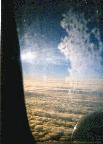 Egyptair
EgyptairWell, it was a long haul to get there, some 27 hours from Phoenix to LA to New York to Cairo but we arrived in Cairo in one piece. Thanks to Kelly for coming out to the airport and greeting us.
HINT: Wait until this page loads completely before you click on any of the thumbnails to see the details of the picture.
 Egyptair
Egyptair
Well, it was a long haul to get there, some 27 hours from Phoenix to LA to New York to Cairo but we arrived in Cairo in one piece. Thanks to Kelly for coming out to the airport and
greeting us.
 The Citadel - The Mosque of Sultan al-Nasir (1318-35)
The Citadel - The Mosque of Sultan al-Nasir (1318-35)
Our first stop in the Citadel. Most of this mosque has been carted away by various ruler to build other mosques but you can see that the builders recycled Roman and Pharonic columns.
 The Citadel - The Mosque of Sultan al-Nasir (1318-35)
The Citadel - The Mosque of Sultan al-Nasir (1318-35)
Looking out from the central courtyard (sahn) at the Mosque of Mohammed Ali. Legend says that St. Francis of Assisi delivered his sermon to the Islamic leader Al-Kamil in this area.
 The Citadel - The Mosque of Sultan al-Nasir (1318-35)
The Citadel - The Mosque of Sultan al-Nasir (1318-35)
The mihrab (niche indicating the direction of Mecca) and minbar (pulpit) of the Mosque.
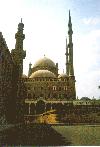 The Citadel - Mohammed Ali Mosque (1824-48)
The Citadel - Mohammed Ali Mosque (1824-48)
Looking south at the Mosque. The Mohammed Ali Mosque is a later addition, almost contemporary in Egyptian time.
 The Citadel - Mohammed Ali Mosque (1824-48)
The Citadel - Mohammed Ali Mosque (1824-48)
The Turkish ablutions fountain with colorful seaside landscapes. The consensus was that it was added on as an afterthought.
 The Citadel - Mohammed Ali Mosque (1824-48)
The Citadel - Mohammed Ali Mosque (1824-48)
The courtyard filled with visiting school children. It was a very popular destination.
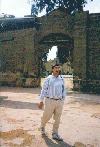 The Citadel - Military Museum
The Citadel - Military Museum
Mark in the middle of the military museum with a Mig-21 in the background. Next to the planes were a group of captured Sherman and Patton tanks.
 Pyramids
Pyramids
Khufu's solar boat that archeologists dug up from 5,000 years ago and painstakingly rebuilt from 1200 pieces of cedarwood.
 Pyramids
Pyramids
Standing at the base of the Great Pyramid and looking up.
 Pyramids
Pyramids
The Great Pyramid of Khufu again but from the base of the pyramid of Khafre. To give a sense of scale, the solar boat museum is at the bottom right.
 Pyramids
Pyramids
The three pyramids with the city of Giza in the background. It was a pretty hazy day.
 Pyramids
Pyramids
Kelly, Mark and Judy in the King's chamber of the Great Pyramid. For a small fee, the keeper insisted on taking a flash picture of us. How could we resist history?
 Pyramids
Pyramids
Here we are again coming out from the pyramid of Khafre. This picture was taken by one of the tourist police.
 Pyramids
Pyramids
Still one of the more amazing works in Egypt (you use the word amazing a lot there).
 Hassan Heshmat
Hassan Heshmat
Hassan Heshmat is one of Egypt's leading artists and he opens his gardens and studio to the general public. Here Scott is posing with a friend.
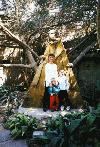 Hassan Heshmat
Hassan Heshmat
Kelly, Mitchell and Scott in front of Hassan's sculpture for the Egyptian family planning agency emphasizing limiting a family to two persons.
 Hassan Heshmat
Hassan Heshmat
Another scupture of an Egyptian woman as a rose.
 Egyptian Antiquities Museum
Egyptian Antiquities Museum
From the Old Kingdom, two lions form a platform for drying out vital organs during the process of mummification (IIRC).
 Egyptian Antiquities Museum
Egyptian Antiquities Museum
Looking down at the sarcophagi collection, usually that was all the was left by the tomb robbers.
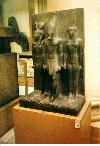 Egyptian Antiquities Museum
Egyptian Antiquities Museum
Also from the Old Kingdom, I believe. The pharoah with Isis on his left and the patron goddess of a
particular province on his left.
 Egyptian Antiquities Museum
Egyptian Antiquities Museum
Part of the King Tut collection, this golden canopic chest guarded by four goddesses.
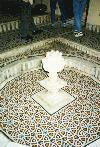 Gayer-Anderson House (1600s)
Gayer-Anderson House (1600s)
This fountain is the centerpiece of the reception hall. A scene in the film The Spy Who Loved Me was shot here.
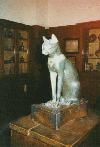 Gayer-Anderson House (1600s)
Gayer-Anderson House (1600s)
The house is a hodge-podge of stuff that Gayer-Anderson collected. In the middle of one room was this statue of Bast, the cat goddess. In the back are various
pieces of pottery and brass that form part of the collection.
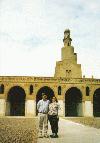 The Mosque of Ibn Tulun (9th century)
The Mosque of Ibn Tulun (9th century)
Right next to the Gayer-Anderson house is the mosque of Ibn Tulun. Here we are in the courtyard, designed to hold thousands of people. In the background is the minaret, modelled after a
Babylonia ziggurat with the spiral steps on the outside. Running around the arcades is a two kilometer long frieze with approximately a fifth of the words of the Koran.
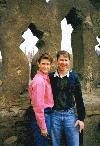 The Mosque of Ibn Tulun (9th century)
The Mosque of Ibn Tulun (9th century)
Here are our hosts in Egypt, Kelly and Mark. They were nice enough to take us to all the places shown here as well as play the
Hercules video for us thirty times.
 The Mosque of Sultan Hassan (1356-1393)
The Mosque of Sultan Hassan (1356-1393)
This is facing the mihrab. You can get an idea of the scale of the mosque by looking at the people.
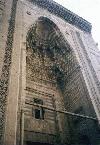 The Mosque of Sultan Hassan (1356-1393)
The Mosque of Sultan Hassan (1356-1393)
The southern liwan (or large niche).
 The Mosque of Sultan Hassan (1356-1393)
The Mosque of Sultan Hassan (1356-1393)
Watching the muezzin performing his noon time prayers. We arrived there just as he began his call and it was very impressive.
 Coptic Cairo
Coptic Cairo
A stained glass window in the Coptic museum. For several hundred years, Egypt was the largest Christian country in the world.
This museum chronicles its art and sculpture.
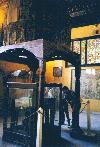 Coptic Cairo
Coptic Cairo
Manal, Kelly and Mark looking at the altar and basillica of the Church of St. Sergius. Dating from the fourth century, this is probably the oldest Christian altar in existance.
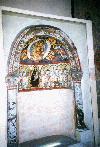 Coptic Cairo
Coptic Cairo
A niche from a monestary showing Jesus and his twelve disciples along with the two Saints that brought Christianity to Egypt.
 Coptic Cairo
Coptic Cairo
The altar cover in the "Suspended Church", showing Christ and a few local saints. The altar is hidden being curtains except during the service. In addition, the sexes are segregated, with the women seated in a different
area from the men.
 Roman Cairo
Roman Cairo
Roman rule is still pretty "recent", closer to today than to the Pyramids. In Roman days, Cairo was still a small town called Babylon. This fortress was built to guard the empire. The Copts
took two pillars from that era and built the "Suspended Church" on them.
Created 3/21/98 -- Last updated 3/31/98